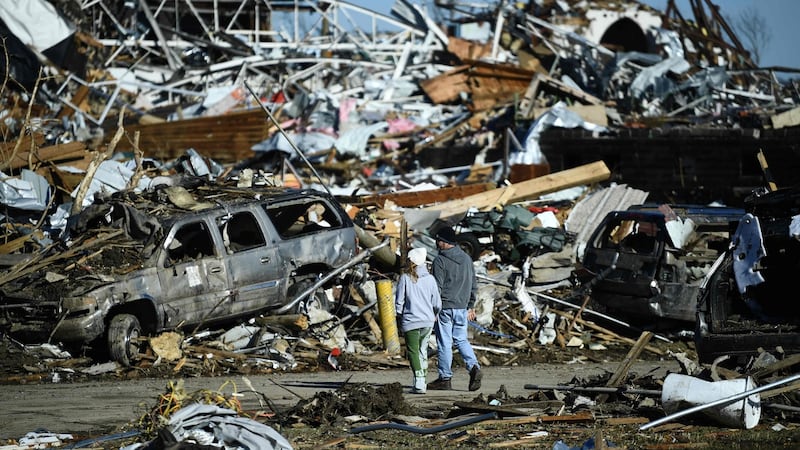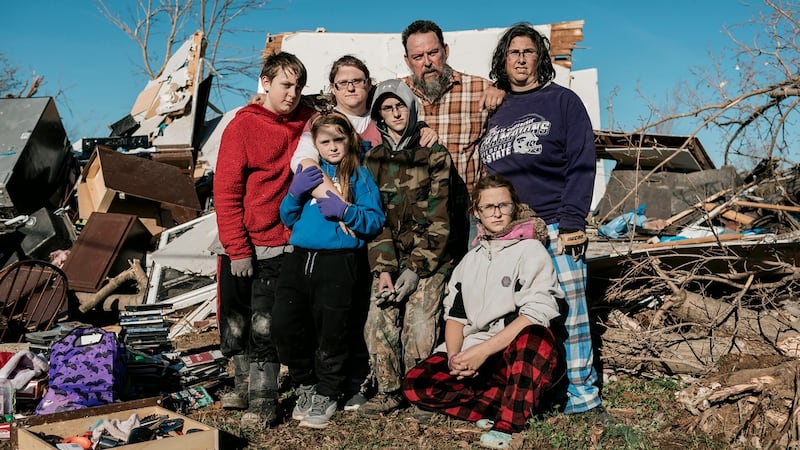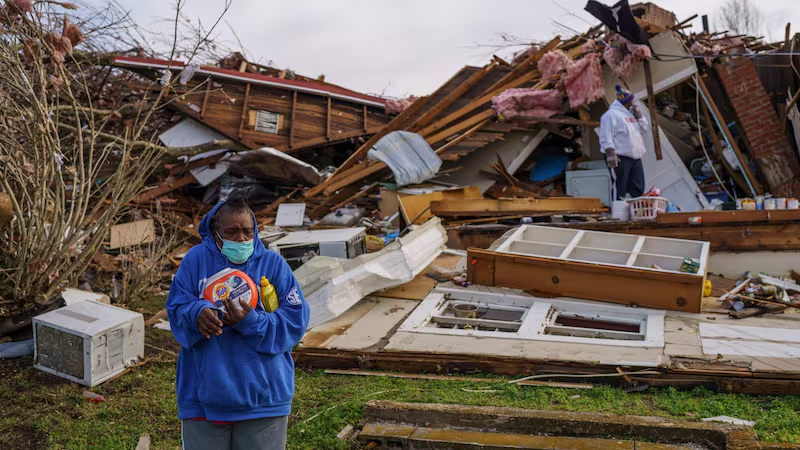Darryl Johnson didn't know what his sister did at the Mayfield Consumer Products factory or why she worked nights; he knew only that her husband dropped her off on Friday evening and that they never heard from her again.
He stood in a gravel lot next to the giant ruin of metal and wood, which just days ago was the candle factory where his sister, Janine Johnson-Williams, had clocked in for her shift. The factory where he works, 70km up the road, shut down when the storms were approaching, Johnson said. He could not find anyone in Mayfield to tell him anything.
Late on Sunday evening, Johnson finally got word. His sister was dead. Sunday was a day of wrenching discoveries across the middle of the country, where an outbreak of tornadoes on Friday night, including one that travelled more than 350 catastrophic kilometres, left a deep scar of devastation. But as work crews dug through ruins and small-town coroners counted the dead Sunday, there was at least a glimmer of hope that the death toll may not end up being as enormous as initially feared.
On Sunday evening, Troy Propes, chief executive of Mayfield Consumer Products, which runs the candle factory that was demolished by the tornado and which many dread may account for the largest number of deaths in the storm, said in an interview that only eight people had been confirmed dead at the factory and another six remained missing.
Bob Ferguson, a company spokesman, said that of the roughly 110 workers who were on the late shift at the factory Friday night, more than 90 employees had been accounted for.
Still, Kentucky governor Andy Beshear told reporters on Sunday that the state had not confirmed those figures and said that search operations were still under way at the site. "There have been, I think, multiple bodies," Mr Beshear said. "The wreckage is extensive."
‘Thousands without homes’
The death toll from the tornado swarm includes people who had been killed in Arkansas, Illinois, Missouri and Tennessee, but the greatest loss of life was unquestionably in Kentucky, where Beshear said that at least four counties had tolls in the double digits. A dozen people were killed in Warren County, several of them children; in Muhlenberg County, there were 11 victims, all in the tiny town of Bremen. One was four months old.

“We’re still finding bodies,” Beshear said. “I mean, we’ve got cadaver dogs in towns that they shouldn’t have to be in.”
In Edwardsville, Illinois, officials released the names of six people who were killed while working at an Amazon delivery depot that was hit by a tornado. "At this time, there are no additional reports of people missing," the Edwardsville Police Department said in a statement on Sunday.
More than 50,000 customers were still without power in Kentucky on Sunday afternoon, and more than 150,000 were without power in Michigan, which was also affected by the sprawling storm. Beshear said there were "thousands of people without homes" in Kentucky, although the sheer amount of devastation made precise figures, at this point, impossible to come by.
“I don’t think we’ll have seen damage at this scale, ever,” he said. But even as the accounting of the storm was slowly being made, much was still dreadfully unknown.
In the town of Dawson Springs, where Beshear's father was born and where his grandfather owned a funeral home, the list of the missing was eight pages long, single-spaced, the governor said in an interview on CNN. Slabs lay bare on the ground where houses once stood along the streets of Dawson Springs. Mattresses hung in trees and were strewn about the housing lots. Teams hunting for victims and survivors left spray-painted symbols on walls that remained standing.
Families bearing bruises and scrapes from Friday night walked among the wreckage, looking through the rubble for medicine, insurance information and food stamps.
Lacy Duke and her family were searching for two missing cats. Between calling out names, they described 22 seconds of deafening horror on Friday night as they huddled in a storm cellar, and an aftermath that was almost apocalyptic. Their house had folded like an accordeon. A mobile home had disappeared. A teenage boy had injured his arm so badly that it had to be amputated. The boy’s grandmother had been stuck under a car.

“This year’s been rough,” Duke said. She had been in a car accident, her son had been sick with Covid-19 and, at the motor parts supplier where she had worked, everyone in her department had been laid off. “And then this happened.”
Current of anger
The storm system’s devastation exposed all along its path a late-night world of warehouses and factories on the outskirts of towns and cities, where people worked handling the seasonal traffic of packages or making scented candles for $8 to $12 (€7.10 to €10.65) an hour. A current of anger ran through the communities that were hit badly in the storm, as people demanded to know why so many were still on the job after alarms had sounded about the approaching danger.
At a Sunday morning church service in Granite City, Illinois, when the pastor asked for prayers for the loved ones of the six who died in the Amazon warehouse, Paul Reagan, a retired steelworker, raised his hand. "There is no reason for us to lose family members," Reagan said, "because corporate America wants a dollar."
In Kentucky, frustration was growing about what transpired at the candle factory, which, in the initial estimates of the toll, accounted for a majority of the estimated deaths statewide. Although officials said that many if not most workers at the factory had been sheltering in a designated place in the building when the tornado hit, some people asked why the factory stayed open well after warnings were raised about the severity of the storms.

The Mayfield Consumer Products factory was one of the largest employers in the county, although employment waxed and waned with layoffs in some years and labour shortages in others The factory was recently advertising 10- and 12-hour shifts, starting at $8 an hour, with mandatory overtime “required frequently”.
Several inmates from the Graves County jail were working there on Friday night as part of an inmate-to-work programme. All survived the storm, according to the jail; a deputy from the jail did not.
Asked why the factory had not shut down on Friday night, Propes said the company had made the best decisions under the circumstances, insisting that having employees hunker down inside the factory was safer than sending them home on the roads.
“Looking through the lens of hindsight, I think, is not the right lens,” he said. “The lens to look through is to say with the same facts, would you make the same decisions? And I think that answer is yes because our team did exactly what they were supposed to do.”
Isaiah Holt (32) was on his shift in the wax and fragrance department when he heard the tornado sirens. On Sunday, he was in a hospital bed in Nashville, Tennessee, aching from a bruised lung and broken ribs and worrying about his brother, who also worked at the factory and who was showered with bricks when the building collapsed. Holt had liked his job, he said. But he questioned whether he the factory should have stayed open after tornado warnings were issued. "They should have just cancelled," he said.
Devastated block
In Mayfield, Angel Romero (38) watched his wife cook chicken soup and heat up tortillas on a stove she had made out of throwaway bricks. Romero, a father of two children, ages 8 and 5, looked around his devastated block, now barely recognisable.
“When it came, it devoured everything in its path,” he said. He looked toward his children. “They are still trying to process what happened.”
The Latino population in Mayfield has grown quickly over the past decade, with immigrants from Mexico and Guatemala and newcomers from Puerto Rico arriving to work in chicken factories and at las Velas – the Candles – the nickname for the factory where many possibly died.
“The Latino community was hit hard by this tragedy,” said Ana Massò, wife of the pastor of the Primera Iglesia Bautista Hispana, where she was collecting donated items to help the people in the community who had been left homeless, lost loved ones or both.
"Many don't know where to go or who to ask for help," she said. "I really don't know where do we go from here." This article originally appeared in The New York Times










